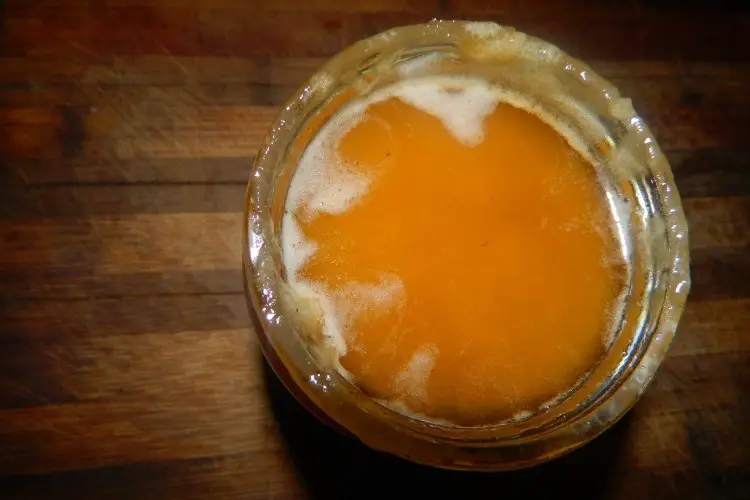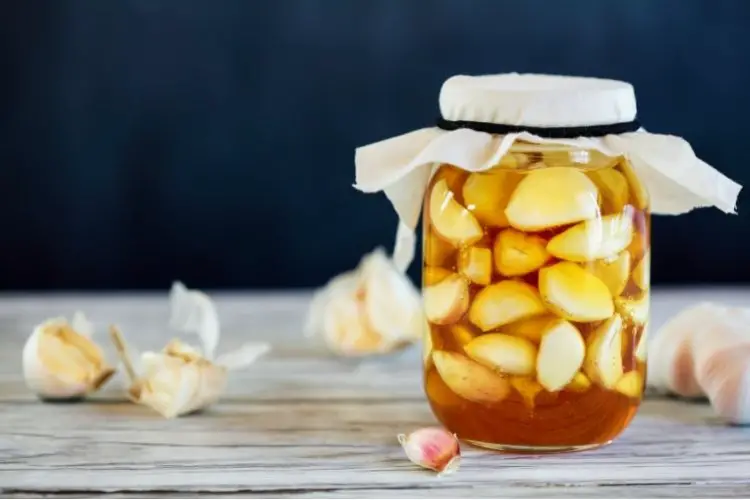Fermented honey results from high moisture content and yeast spores naturally present in honey. Sufficient moisture and warm temperature will cause the honey to ferment unless it’s pasteurized.
What Is Fermentation And Why Does Honey Ferment?
Fermentation is when an organism breaks down carbohydrates like sugar, turns them into alcohol or acid.
Honey is mainly made of glucose, fructose, and water; however, it also contains yeast. This happens as bees fly from one flower to another when they forage and bring with them the yeasts naturally found in flowers.
Yeast, Fermentation, And Water Content In Honey
Under high moisture environments, the yeasts will reproduce and cause fermentation.
The higher count of yeast spores in a given batch of honey, the lower the water content should be to reduce the risk of fermentation.

That’s why most countries set a quality standard of water content in honey between 17% and 21%.
While determining how many yeast spores your honey has can be a difficult task, tackling the water content of honey effectively reduces the risk of fermentation and is easy to measure with the help of a refractometer.
Yeast, Fermentation, And Temperature
Another essential factor in fermentation and yeast growth is temperature.
At temperatures below 52º F (11.1º C), yeast will stay inactive, which means it won’t reproduce or produce fermentation, BUT it won’t die either.
Many beekeepers freeze or keep honey with high moisture content in the fridge for this reason – it delays the process of fermentation.
Note: I also usually recommend leaving honey with high water content for personal use. I don’t think it’s a good idea to sell or give away honey if the moisture reading is above the food quality standards.
At temperatures between 53 F (11.6º C) and up to 99 F (37.2º C), the yeasts will break down the sugars and grow significantly. Therefore, the honey is very likely to ferment (provided the honey moisture is high).
Heating up honey to temperatures above 100 F (37.7º C) will kill the yeast spores, therefore, eliminating the risk of fermentation and preventing crystallization as a bonus.
However, it is not as easy as heating it up for a few minutes at any high temperature and voila! Fermentation crisis averted.
To kill yeast effectively, the temperature must be maintained for some time.
Temperature And Time Needed To Kill Yeast Effectively.
| Temperature | Time Need To Kill Yeast In Honey |
| 100 F (37.7º C) | Several months |
| 122 F (50º C) | 24 hours |
| 145 F (62.7º C) | 30 min |
| 160 F (71.1º C) | 1 min |
You need to keep in mind another issue – processing honey by using heat can alter other properties like color and flavor when not done correctly or under controlled conditions.
This can be very difficult to accomplish without the use of specialized equipment and facilities.
Therefore, most backyard beekeepers decide to invest in a refractometer. Measuring the moisture content instead of pasteurizing their honey can be a lot cheaper!
How To Know If Honey Is Fermented
The first indication that your honey is fermented is the smell. Honey’s acidic content increases throughout the fermentation process, giving off a smell like that of wine.
When honey is fermenting, its appearance will change, and bubbles will start to show up. In some cases, you will also see foam on the top layer.
Another way to check your honey is by tasting it. Fermented honey will have a sharp and sour taste.
Is Fermented Honey Safe To Eat?
Fermented honey is generally safe to eat, but keep in mind its taste will change noticeably.
Before you venture into eating or using the fermented honey, check for other sources of contamination. While fermentation from the natural presence of yeast doesn’t make honey unsafe for consumption, other bacteria or microorganisms could.
If you suspect your honey has been contaminated throughout the harvesting or packaging process, it’s better not to eat it.
What To Do With Fermented Honey?
Let’s say you don’t want to process your honey, and despite all your efforts, the moisture in your honey just won’t go down. Will all these months of hard work (from both you and your bees) be for nothing?
Here’s a list of things you can do with fermented honey before you reach for the trash.
- Use it with your food: Fermented honey is an excellent food additive. You can have the health benefits of honey while also satisfying your sweet tooth. It goes well on yogurts, cereals, oatmeal, fruits, and smoothies or juice blends.
- Make fermented honey and garlic: this is probably one of the most popular combinations to make with honey, and fermenting it will only add more richness. Here’s how to do it correctly:
- First, choose a batch of high-moisture honey and peel a few cloves of garlic.
- Next, clean and sterilize a glass jar by boiling it in water.
- Pour the honey into the jar without filling completely. Leave at least a quarter of the jar empty – this is important because as the mixture ferments, some gas will build up.
- Make sure the garlic is completely covered in honey. Then, close the lid and let it sit.
- For the first couple of weeks, tip the jar upside down every day to mix everything in and make sure all parts of the garlic are covered in honey.
- When the mixture starts showing bubbles, it means it’s fermenting. Make sure to open and close the lid quickly so the built-up gas can be released – just like it happens when you open a bottle of soda. Repeat this every now and then.
- And there it is. After a few weeks, you’ll have a new kitchen trick up your sleeve that will make your foods more sophisticated.
- Ferment it as a combo: You can ferment pure honey and add your favorite fruits or vegetables by repeating the steps above. Use the mixtures as marinades or toppings to raise your dishes to the next level!

Can You Make Mead With Fermented Honey?
Although mead is an alcoholic beverage made by fermenting honey, using already fermented honey can result in a sour-tasting mead.
Mead is made by adding water and specific types of yeast to honey.
When you use honey that is already fermenting, there is no control over the yeast causing the fermentation (and other microorganisms). Therefore, the flavor of the final product can be unpredictable.
In saying that, you can absolutely do it and see how it turns out. It’s entirely up to you. Who knows? Maybe you’ll end up with a tasty beverage by accident.
Summary – What is Fermented Honey and What To Do With it?
What is fermented honey? It’s when added moisture and warmth accelerate the yeast’s consumption of the sugars found in honey.
Fermented honey can have many uses in the kitchen that can elevate your dishes and save you from throwing months of hard work into the trash.
